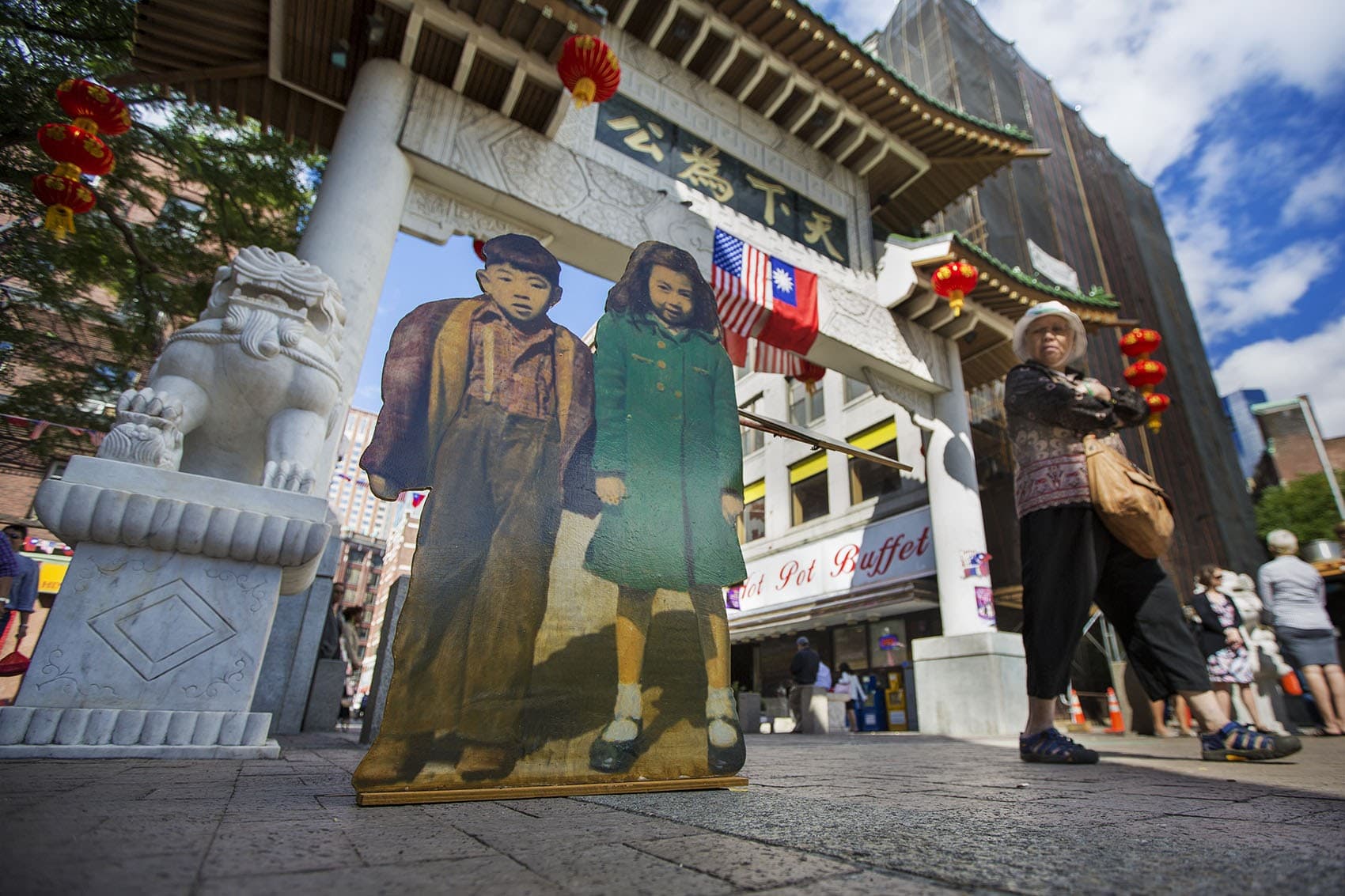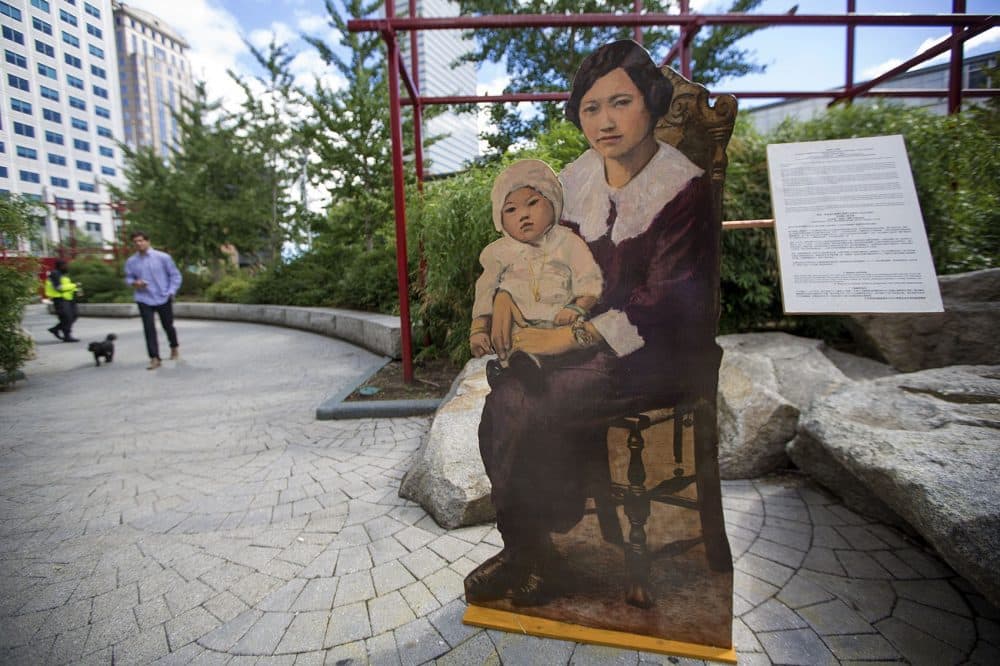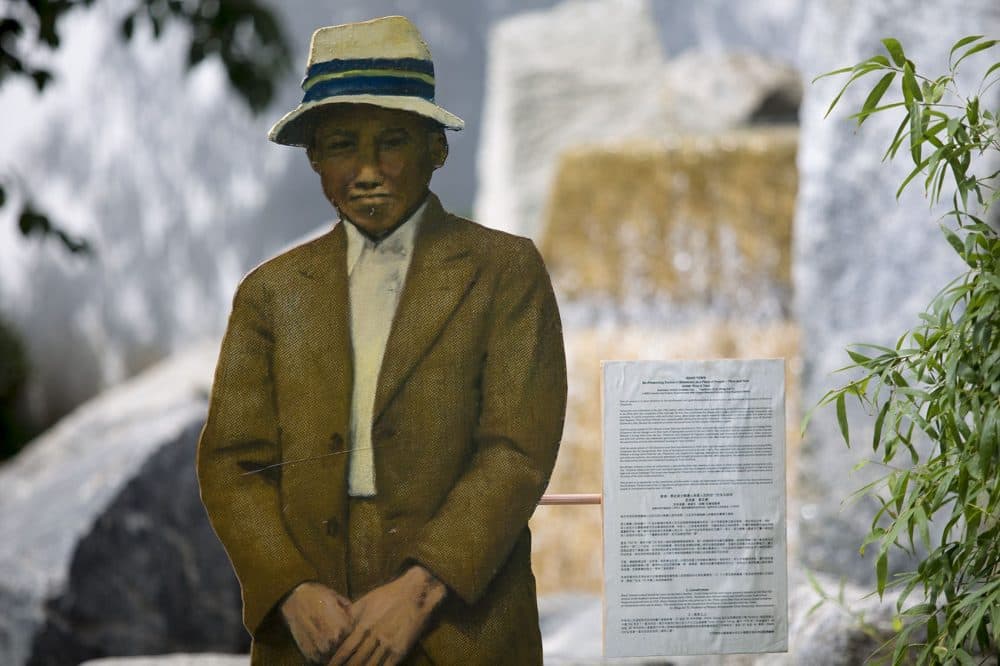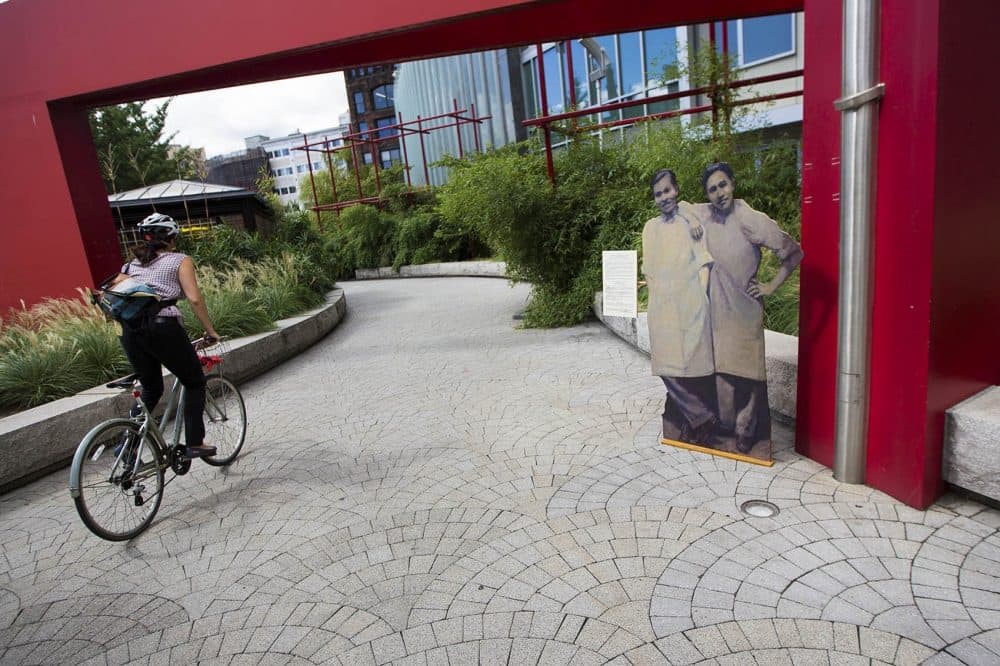Advertisement
Artist Wen-Ti Tsen Returns 12 Long-Absent Residents To Boston's Chinatown
Resume
In Boston's Chinatown, 12 long-absent residents have returned. They are men and women, grandparents, professors, workers and small children who haven't seen the bricks and banners of Chinatown for 50, 60, even 100 years. The people are life-sized images from Chinatown's past.
"Home Town: Re-presenting Boston’s Chinatown as Place of People — Then and Now" is a remarkable art installation with 12 historical photos, enlarged, transferred to wooden sheets, and lovingly hand-painted by 80-year-old artist Wen-Ti Tsen.
Tsen says the figurines have come home. But this is a changing home today.
Chinatown is rapidly gentrifying, which is why Tsen says, as modern-day Bostonians walk around the installation, coming eye-to-eye with faces from the past, he hopes people will take in their existence, see how the neighborhood has changed, see them with sisterly and brotherly empathy and notice their historical lives.
We met Tsen and his evocative wooden cutouts right under the Chinatown Gate where the image of a little boy and girl greeted us.
"This is a boy and a girl. I think the boy looks about 4-years-old and the girl maybe two years older," Tsen says. "It was from a picture that was taken, I assume, in the early '40s."
Tsen thinks the photo was taken just down the street from the Chinatown Gate in Boston, where the children lived.
"In fact, these are two people who later grew into important people in the community," he says. "One is Reggie Wong and the other one is Katherine Wong, I think. They were kind of the pillars of the community. When you look at the little boy, about 4-years-old, and you look at his face, that's what fascinates me."
Showing The History Of A Changing Place
The title of the installation is "Home Town" — two separate words. Tsen says he is aiming to re-present Boston's Chinatown as a place of people.
"The reason I use 'Home Town' as two separate words is because one's association with 'Hometown America' — or 'Hometown USA' -- has a certain quality that is almost a Midwestern town, with lawns in the front. What I'm trying to say is that actually Chinatown itself is home to a lot of people. The whole idea is that it's been here for over 100 years," Tsen says. "So the home in that sense is much wider than the geographic area of Chinatown. It has become home of all the Chinese Americans in New England."

Tsen says that he wanted to take on this installation now because the neighborhood is being threatened by development.
"This home that we're talking about is actually being threatened ... by different types of expansion of the city," he said.
Back in the 1960s, urban renewal brought new highways — and demolition.
"A lot of the inner city at that time was devalued. They say Chinatown especially was devalued in the sense that it didn't have much political power in City Hall so they looked at it like a derelict place. ... [Then in] the '80s, people were gathering together with newcomers from China who were younger people, college-educated. They would become activists, saying the community does not have to be like a ghetto, ruling themselves, that they could actually get services from the city."
However, the situation today is more economic, Tsen says.
"When you have a block with three- or four-story buildings that rent for a few hundred dollars with people been living there 50 years or something -- when you have offers of building 50-story high buildings, with the top floor for several million dollars, then the temptation to sell was very, very great," he says.
'Relating To Us As Real People'
The fact that the figures are life-sized and the images are colorized makes it feels as if these people are here with us.
"For me, one was a funeral quality of bringing back ghosts, but by colorizing them I can almost make them alive, so that they are relating to us as real people," Tsen says.
We come across the figure of a man wearing a bow tie, very smartly dressed and a walking stick.
"I love him. It was taken from a photo at a picnic in the early 20th century. They tried to learn how to become Americans — Americanize — at that time. He obviously had a pretty good tutor who got him into a very smart dress with a rose in his button hole," Tsen says. "What I've tried to capture is that there was a kind of pride in his appearance. It's a black and white photo, but I also tried to recreate the feeling that people used to have of coloring photographs in the Civil War."
Tsen says he found the photographs from the Chinese Historical Society of New England, which is a partner of the project. But it was difficult to find photographs of people at work.
"All the pictures are of people who are in a position of — more or less — power," he says. "It's very strongly oriented toward a patriarchal society."
Although, he was able to find a photograph of a laundry man.

"He was the last one I found — in fact, I couldn't find him, couldn't find any working people in the books. In his portrait, he looked like a rather small person, but I made him in between so that he's about my size, but I think he might have been about 5'2" or something like that. His gesture is very contained," Tsen says. "It shows his hard life. For me, he represents all the hard work the Chinese laundrymen have gone through in all those years. That's why, when I put in his eyes, there's a quality of his humanity that is coming through. That we're relating to each other."
His hands are crossed just below his waist. He's wearing very simple clothes — jacket and pants and a white shirt.
"When I looked at him in total, he has a hat on that looks like it's from a second-hand clothing store. Some cap leftover from a Harvard student and his clothes are rather unfitting. At the same time, creased and his shoes are polished. I think it was his Sunday best."
A Changing Definition Of 'Home'
It's clear that the idea of home is very important for Tsen. He's had a life of global travel, whether he wanted it or not.
"When I grew up in China, I had home for like three or four years — a real home that I loved — but then I was never there because of the revolution and second World War. Then I'd move from our home to another city. Then to another country — to Paris, London. So home became the part that I carried within me. Being Chinese, I find that home is a visionary thing within. My home is different than another Chinese American's home. That's why I think 'Home Town,' like Chinatown, in a way, creates that feeling that we have a certain amount of things together."
Tsen says he had to leave China after the revolution. Since his mother was educated in France, it was a natural choice to go back to Paris. Then Tsen was sent to school in London — "post-second World War, which wasn't a very nice place," he says.
His brother started teaching in Boston so his mother and other brother followed, but Tsen stayed in Europe to finish art school for two more years.
"Being an immigrant, you have several layers of yourself," Tsen says. "You can open up different homes there are 10 different homes. When I'm in Chinatown, I open one door. When I'm in Nantucket or Martha's Vineyard, I open different doors. It's only in America that you can have that. In Europe, an immigrant is an outsider. In America, you can be an American and an immigrant too."

"Home Town: Re-presenting Boston’s Chinatown as Place of People — Then and Now" is on display until October 2.
This article was originally published on September 15, 2016.
This segment aired on September 15, 2016.

